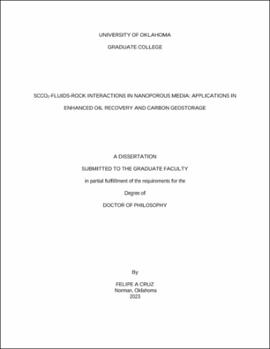| dc.contributor.advisor | Rai, Chandra | |
| dc.contributor.author | Adriao Cruz, Felipe | |
| dc.date.accessioned | 2023-12-07T22:59:20Z | |
| dc.date.available | 2023-12-07T22:59:20Z | |
| dc.date.issued | 2023-12-15 | |
| dc.identifier.uri | https://hdl.handle.net/11244/340020 | |
| dc.description.abstract | A global effort to reduce atmospheric CO2 levels and mitigate global warming is ongoing. Carbon capture and storage (CCS) and enhanced oil recovery (EOR) are pivotal technologies for achieving net-zero emissions, further incentivized by U.S. tax benefits. Both practices involve injecting CO2 into subsurface geological formations, where it transitions into a dense supercritical fluid phase (scCO2). Understanding interactions between scCO2, native fluids, and the subsurface formation, is crucial for optimizing EOR and managing risks in carbon geostorage (CGS). These interactions are particularly complex in nanoporous systems, such as confining zones in CGS, and during cyclic-gas injection (Huff and Puff, or HnP) in unconventional liquid-rich shale reservoirs (ULR).
This dissertation comprises two studies examining the impact of these interactions on HnP-EOR in ULR and the long-term integrity of confining zones in CGS. The first study involves over 20 HnP-EOR tests on preserved ULR samples, coupled with analytical tools to evaluate key parameters affecting crude oil and brine mobilization. Additionally, a shale oil reservoir model was developed to simulate HnP-EOR in ULR and assess net carbon efficiency. In the second study, scCO2 treatments were conducted for 21 days in five confining zones and one storage zone sample under elevated temperature and pressure (150 °F and 3000 psi). A strategy was devised to monitor geochemical reactivity at the surface level down to the micrometer depth of invasion. Before and after treatment, pore size distributions and effective matrix diffusivities were determined. ScCO2-brine-rock wettability and breakthrough tests were conducted under subsurface conditions. Following integration of these two studies with critical literature review, valuable insights into fluid recovery during HnP-EOR in ULR and the integrity of confining zones in CGS are provided. | en_US |
| dc.language | en_US | en_US |
| dc.subject | Carbon Capture and Storage (CCS) | en_US |
| dc.subject | Enhanced Oil Recovery (EOR) | en_US |
| dc.subject | Supercritical Carbon Dioxide (scCO2) | en_US |
| dc.subject | Shales | en_US |
| dc.title | ScCO2-Fluids-Rock Interactions in Nanoporous Media: Applications in Enhanced Oil Recovery and Carbon Geostorage | en_US |
| dc.contributor.committeeMember | Bedle, Heather | |
| dc.contributor.committeeMember | Shiau, Benjamin | |
| dc.contributor.committeeMember | Devegowda, Deepak | |
| dc.contributor.committeeMember | Dang, Son | |
| dc.date.manuscript | 2023-04-03 | |
| dc.thesis.degree | Ph.D. | en_US |
| ou.group | Mewbourne College of Earth and Energy::Mewbourne School of Petroleum and Geological Engineering | en_US |
